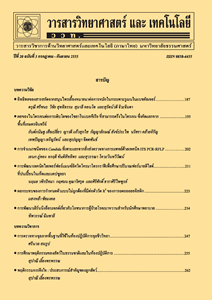การจำแนกพันธุ์และความสัมพันธ์ทางพันธุกรรมของกล้วยไม้ช้างและลูกผสมด้วยเครื่องหมายแฮตอาร์เอพีดี
Main Article Content
Abstract
บทคัดย่อ
กล้วยไม้สกุลช้างเป็นกล้วยไม้ไทยที่มีความสำคัญและได้รับความนิยม แต่ปัจจุบันการจำแนกพันธุ์ตามสัณฐานวิทยามีความยุ่งยากและเกิดความสับสน เนื่องจากมีการปรับปรุงพันธุ์ด้วยการผสมพันธุ์และขยายพันธุ์ด้วยการเพาะเลี้ยงเนื้อเยื่อ ดังนั้นงานวิจัยนี้จึงนำเทคนิคแฮตอาร์เอพีดีมาตรวจสอบพันธุ์กล้วยไม้ช้างและลูกผสม 13 พันธุ์ โดยใช้ไพรเมอร์แบบสุ่ม 72 ชนิด พบว่าไพรเมอร์ 41 ชนิด สามารถเพิ่มปริมาณดีเอ็นเอได้ เมื่อคัดเลือกไพรเมอร์ 29 ชนิด ที่ให้ลายพิมพ์ดีเอ็นเออย่างชัดเจนมาตรวจสอบกับดีเอ็นเอของกล้วยไม้ช้างและลูกผสมแต่ละพันธุ์ พบว่าสามารถแยกความแตกต่างระหว่างพันธุ์ได้ด้วยแถบดีเอ็นเอจำเพาะกับพันธุ์ นอกจากนั้นยังพบไพรเมอร์ 5 ชนิด ที่สามารถจำแนกกล้วยไม้ช้างและลูกผสมทั้ง 13 พันธุ์ ได้โดยใช้ไพรเมอร์เพียงชนิดเดียว เมื่อวิเคราะห์ความสัมพันธ์ทางพันธุกรรมพบว่ามีค่าสัมประสิทธิ์ความเหมือนอยู่ระหว่าง 0.61 ถึง 0.84 โดยผลการวิจัยครั้งนี้แสดงให้เห็นว่าเครื่องหมายแฮตอาร์เอพีดีใช้ระบุชนิดของกล้วยไม้ช้างและลูกผสมได้ ซึ่งสามารถนำไปวางแผนการผสมพันธุ์เพื่อพัฒนาพันธุ์ใหม่ ๆ ในอนาคต
คำสำคัญ : กล้วยไม้ช้าง; ความสัมพันธ์ทางพันธุกรรม; การจำแนก; เครื่องหมายดีเอ็นเอ; แฮตอาร์เอพีดี
Abstract
Rhynchostylis is one of an important and popular orchid in Thailand. However, identification based on morphology is difficult and because of the occurrence of new varieties from breeding program and tissue culture. High annealing temperature-random amplified polymorphic DNA (HAT-RAPD) technique was used to identify 13 samples of Rhynchostylis gigantea and their hybrids. The total 72 random primers were screened and 41 primers could be used for DNA amplification. Twenty-nine primers which gave clear amplified products were selected and used to analyze all samples. The result showed differences among 13 samples with specific DNA bands. In addition, 5 of 29 random primers were found to identify each sample using only one primer. A dendrogram based on polymorphic bands showed genetic similarities among R. gigantea and their hybrids with similarity coefficients ranging from 0.61 to 0.84. Finally, these results indicated that the HAT-RAPD markers are capable of R. gigantea and their hybrids verification, which will be useful in the breeding program.
Key words : Rhynchostylis gigantea; genetic relationship; identification; DNA marker; HAT-RAPD


